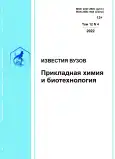Биоинформатический метод определения однонуклеотидных полиморфизмов на примере гена WIN у Glycine max
- Авторы: Тимкин П.Д.1, Пензин А.А.1
-
Учреждения:
- Всероссийский научно-исследовательский институт сои
- Выпуск: Том 12, № 4 (2022)
- Страницы: 599-604
- Раздел: Физико-химическая биология
- URL: https://bakhtiniada.ru/2227-2925/article/view/301209
- DOI: https://doi.org/10.21285/2227-2925-2022-12-4-599-604
- ID: 301209
Цитировать
Полный текст
Аннотация
Ключевые слова
Об авторах
П. Д. Тимкин
Всероссийский научно-исследовательский институт сои
Email: tpd@vniisoi.ru
А. А. Пензин
Всероссийский научно-исследовательский институт сои
Email: paa@vniisoi.ru
Список литературы
- Lander E. S. Initial sequencing and analysis of the human genome. Nature. 2001;409:860-921. https://doi.org/10.1038/35057062.
- Makki R. M., Saeedi A. A., Khan T. K., Ali H. M., Ramadan A. M. Single nucleotide polymorphism analysis in plastomes of eight Catharanthus roseus cultivars. Biotechnology & Biotechnological Equipment. 2019;33(1):419-428. https://doi.org/10.1080/13102818.2019.1579671.
- Sukhumsirichart W. Polymorphisms. In: Genetic Diversity and Disease Susceptibility. Liu Ya. (ed.). 2018, 164 p. https://doi.org/10.5772/intechopen.76728.
- Morgil H., Gercek Y. C., Tulum I. Single nucleotide polymorphisms (SNPs) in plant genetics and breeding. In: The Recent Topics in Genetic Polymorphisms. Çalışkan M., Erol O., Öz G. C. (eds.). 2020, 148 p. https://doi.org/10.5772/intechopen.91886.
- Achard F., Butruille M., Madjarac S., Nelson P. T., Duesing J., Laffont J.-L., et al. Single nucleotide polymorphisms facilitate distinctness-uniformity-stability testing of soybean cultivars for plant variety protection. Crop Science. 2020;60(5):2280-2303. https://doi.org/10.1002/csc2.20201.
- Freudenthal J. A., Ankenbrand M. J., Grimm D. G., Korte A. GWAS-flow: a GPU accelerated framework for efficient permutation based genome-wide association studies. BioRxiv. 2019;1:783100. https://doi.org/10.1101/783100.
- Fan C., Zhai H., Wang H., Yue Y., Zhang M., Li J., et al. Identification of QTLs controlling grain protein concentration using a high-density SNP and SSR linkage map in barley (Hordeum vulgare L.). BMC Plant Biology. 2017;17:122. https://doi.org/10.1186/s12870-017-1067-6.
- Zhang W., Xu W., Li S., Zhang H., Liu X., Cui X., et al. GmAOC4 modulates seed germination by regulating JA biosynthesis in soybean. Theoretical and Applied Genetics. 2022;135(2):439-447. https://doi.org/10.1007/s00122-021-03974-0.
- Mathur R., Rana B. S., Jha A. K. Single nucleotide polymorphism (SNP). In: Encyclopedia of Animal Cognition and Behavior. Vonk J., Shackelford T. (eds.). Cham., Springer; 2018, 7539 p. https://doi.org/10.1007/978-3-319-47829-6_2049-1.
- Tchaikovskii V., Desnick R. J., Bishop D. F. Molecular expression, characterization and mechanism of ALAS2 gain-of-function mutants. Molecular Medicine. 2019;24(25):4. https://doi.org/10.1186/s10020-0190070-9.
- Martynenko N., Lavrentieva S., Tarasova O. Influence of Septoria glycines Hemmi on the enzymes’ activity of hydrolytic Glycines max (L.) Merr seed complex. Fundamental and Applied Research in Biology and Agriculture: International Scientific and Practical Conference. 2021;254:02020. https://doi.org/10.1051/e3sconf/202125402020.
- Howe K. L., Contreras-Moreira B., De Silva N., Maslen G., Akanni W., Allen J., et al. Ensembl genomes 2020 – enabling non-vertebrate genomic research. Nucleic Acids Research. 2020;48(D1):D689-D695. https://doi.org/10.1093/nar/gkz890.
- Rensink W. A., Buell C. R. Arabidopsis to rice. Applying knowledge from a weed to enhance our understanding of a crop species. Plant Physiology. 2004;135(2):622-629. https://doi.org/10.1104/pp.104.040170.
- Coelho S. M., Peters A. F., Charrier B., Roze D., Destombe C., Valero M., et al. Complex life cycles of multicellular eukaryotes: new approaches based on the use of model organisms. Gene. 2007;406(1-2):152-170. https://doi.org/10.1016/j.gene.2007.07.025.
- Meyerowitz E. M. Prehistory and history of Arabidopsis research. Plant Physiology. 2001;125(1):15-19. 16. Leonelli S. Arabidopsis, the botanical Drosophila: from mouse cress to model organism. Endeavour. 2007;31(1):34-38. https://doi.org/10.1016/j.endeavour.2007.01.003.
- Lan Y., Sun R., Ouyang J., Ding W., Kim M. J., Wu J., et al. AtMAD: Arabidopsis thaliana multi-omics association database. Nucleic Acids Research. 2021;49(D1):D1445-D1451. https://doi.org/10.1093/nar/gkaa1042.
- Jampala P., Garhewal A., Lodha M. Functions of long non-coding RNA in Arabidopsis thaliana. Plant Signaling & Behavior. 2021;16(9):1925440. https://doi.org/10.1080/15592324.2021.1925440.
- Yu X., Vandivier L. E., Gregory B. D. NAD-seq for profiling the NAD+ capped transcriptome of Arabidopsis thaliana. STAR Protocols. 2021;2(4):100901. https://doi.org/10.1016/j.xpro.2021.100901.
Дополнительные файлы










